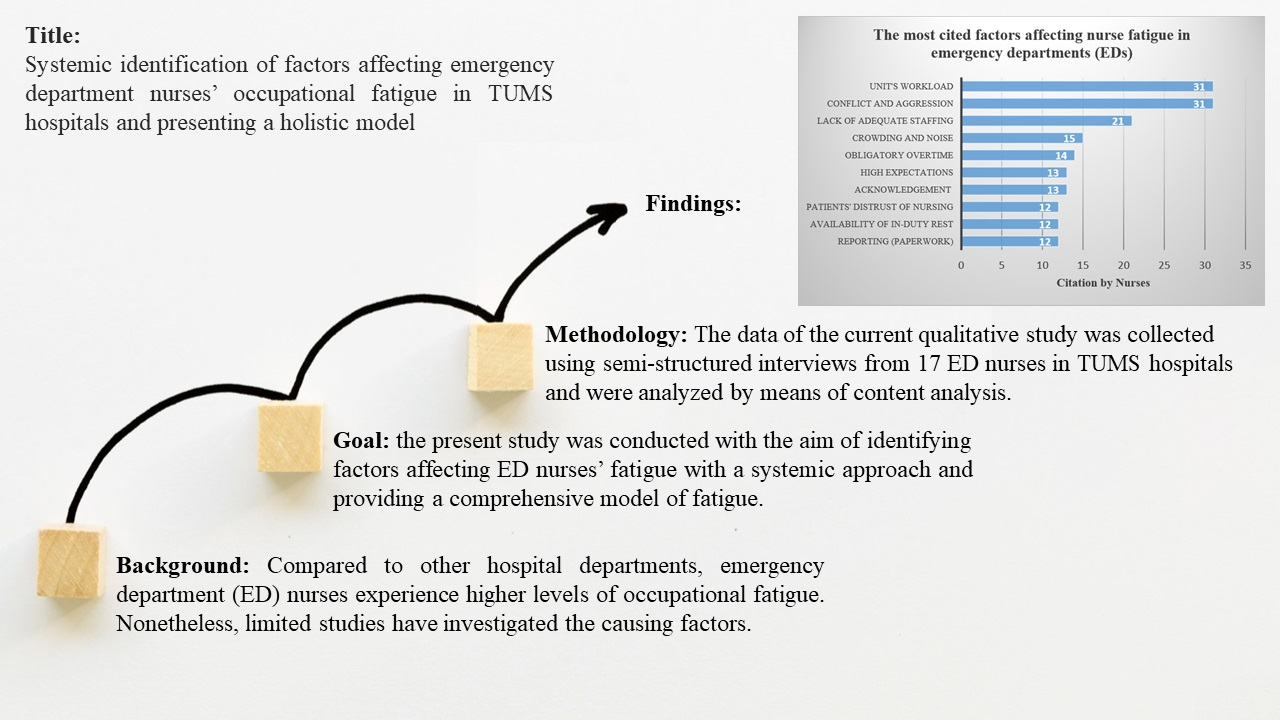Volume 13, Issue 3 (9-2023)
J Health Saf Work 2023, 13(3): 617-644 |
Back to browse issues page
Download citation:
BibTeX | RIS | EndNote | Medlars | ProCite | Reference Manager | RefWorks
Send citation to:



BibTeX | RIS | EndNote | Medlars | ProCite | Reference Manager | RefWorks
Send citation to:
hosravi Danesh M K, Mazloumi A, Cheraghi M A, Nejat S, Wolf L A. Systemic Identification of Factors Affecting Emergency Department Nurses’ Fatigue in TUMS Hospitals and Developing a Holistic Model. J Health Saf Work 2023; 13 (3) :617-644
URL: http://jhsw.tums.ac.ir/article-1-6882-en.html
URL: http://jhsw.tums.ac.ir/article-1-6882-en.html
Mojtaba K Hosravi Danesh * 
 1, Adel Mazloumi2
1, Adel Mazloumi2 
 , Mohammad Ali Cheraghi3
, Mohammad Ali Cheraghi3 
 , Saharnaz Nejat4
, Saharnaz Nejat4 
 , Lisa. A. Wolf5
, Lisa. A. Wolf5 


 1, Adel Mazloumi2
1, Adel Mazloumi2 
 , Mohammad Ali Cheraghi3
, Mohammad Ali Cheraghi3 
 , Saharnaz Nejat4
, Saharnaz Nejat4 
 , Lisa. A. Wolf5
, Lisa. A. Wolf5 

1- Department of Occupational Health Engineering, School of Public Health, Tehran University of Medical Sciences, Tehran, Iran , m-danesh@razi.tums.ac.ir
2- Department of Occupational Health Engineering, School of Public Health, Tehran University of Medical Sciences, Tehran, Iran and Sports Medicine Research Center, Neuroscience Institute, Tehran University of Medical Sciences, Tehran, Iran
3- Critical Care and Nursing Management Department, School of Nursing and Midwifery, Tehran University of Medical Sciences, Tehran, Iran
4- Department of Epidemiology and Biostatistics, Knowledge Utilization Research Center, School of Public Health, Tehran University of Medical Sciences, Tehran, Iran
5- Institute for Emergency Nursing Research, Emergency Nurses Association, Schaumburg, IL, USA
2- Department of Occupational Health Engineering, School of Public Health, Tehran University of Medical Sciences, Tehran, Iran and Sports Medicine Research Center, Neuroscience Institute, Tehran University of Medical Sciences, Tehran, Iran
3- Critical Care and Nursing Management Department, School of Nursing and Midwifery, Tehran University of Medical Sciences, Tehran, Iran
4- Department of Epidemiology and Biostatistics, Knowledge Utilization Research Center, School of Public Health, Tehran University of Medical Sciences, Tehran, Iran
5- Institute for Emergency Nursing Research, Emergency Nurses Association, Schaumburg, IL, USA
Abstract: (950 Views)
Introduction: Compared to other hospital departments, emergency department (ED) nurses experience higher levels of occupational fatigue. However, despite the importance of fatigue in EDs, limited studies have investigated the issue. Therefore, the present study aimed to identify factors affecting ED nurses’ fatigue with a systemic approach and provide a comprehensive model of fatigue.
Material and Methods: The present study was the first phase of a mixed-methods study with an exploratory sequential design that was conducted qualitatively. Data was collected using a semi-structured interview technique among ED nurses in TUMS hospitals in Tehran. The data was analyzed with a systematic approach and qualitative content analysis method. To check the credibility and trustworthiness of the study results, Goba and Lincoln criteria, including transferability, peer review, and member check, were used.
Results: Extensive factors were identified in the four levels of nurses’ work system, including individual factors, work unit, organization, and extra-hospital factors that could facilitate or prevent nurse fatigue. Specifically, the categories that were mentioned the most by the nurses were aggression and conflict with visitors, ED workload, understaffing, crowding and noise, obligatory overtime, acknowledgement, visitor’s expectations, reporting (paperwork), and clients’ distrust of nurses. Finally, based on the qualitative results, a conceptual model of factors affecting occupational fatigue of ED nurses in Tehran was presented.
Conclusion: Traditionally, fatigue management programs in hospitals only consider issues related to work shifts and sleep hygiene. However, the results of the present study revealed other fatiguing factors in the work system of ED nurses. These findings can help health system decision makers and HFE experts in designing effective fatigue risk management systems in Iranian hospitals, especially in emergency departments.
Type of Study: Research |
Received: 2023/09/30 | Accepted: 2023/09/23 | Published: 2023/09/23
Received: 2023/09/30 | Accepted: 2023/09/23 | Published: 2023/09/23
Send email to the article author
| Rights and permissions | |
 |
This work is licensed under a Creative Commons Attribution-NonCommercial 4.0 International License. |




